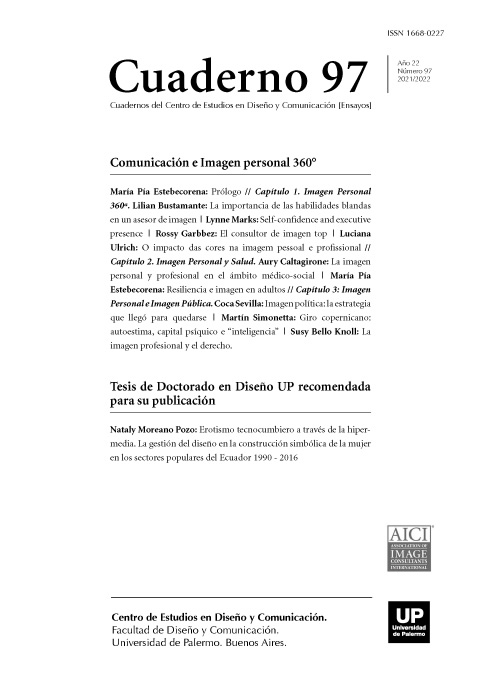Imagen personal y resiliencia en adultos
Abstract
When I embarked on the drafting of this paper, I decided to write about a topic which, in my opinion, offers people the greatest hope and transformation channels: resilience. I quickly found a common ground and therefore decided to address the impact of resilience on Personal Image as this is my field of work. It was very enriching for me to tie this research work to the over 900 consultancy sessions I have offered together with my partner over the last 17 years of continuous work on personal image.
These consultancy sessions have been aimed at people with different profiles and of different nationalities all over Latin America. Within this universe, we have worked with all types of professionals, men and women of between 20 and 70 years of age, who were looking forward to a change since they felt their image did not represent who they really were. It is also worth mentioning our teaching experience as university professors of Image and Style II at the University of Palermo (Universidad de Palermo), a renowned university in the city of Buenos Aires.
We have also worked with people suffering from serious diseases, such as women with cancer on a treatment of chemotherapy, who were eager to rebuild their image and repair their badly damaged self-esteem both in Panama and in Argentina. There was an element in common in all this diversity: any person on the way to a change started out from a state of resilience, or else expected to strengthen such state as a measure of precaution so that they would be better equipped in the face of future hardship I will always be dazzled by the enormous capacity in human beings to transform an intricate situation and look for resources to protect themselves within the state of resilience.
In the personal sphere, I am very pleased, and therefore feel highly motivated, to have found within the world of Personal Image a path of assistance and prevention that can help people in different aspects but with a common denominator: the strengthening of a person’s self-esteem so that he/she can have a positive life experience and find happiness within himself/herself.
In the professional sphere, this premise encourages to demonstrate that a person’s Image is not something superficial or frivolous, a “girly thing”, something merely incidental or just linked to fashion, as is usually regarded by the public at large. Facilitating this integral look within the world of Personal Image represents a turning point in my career.
References
Rosemberg, M. & Owens (2001). Low self-esteem: a collective portrait. NY: Cambridge Univ.
Coopersmith, S. (1967). The antecedents of self-esteem. San Fracisco. Curie, C.; Roberts, C. & Morgan, A. Young people health in context. Health behaviour in school-aged: international report from the 2001/2002 survey. Copenhague: OMS.
Grotberg, E. (1991). A guide to promoting resilience in children: Strenghthening the human spirit. La Haya: The Bernard Van Leer Foundation.
Manual de identificación y promoción de la resiliencia en niños y adolescentes. Munist, Santos, Kotliarenco, Suarez Ojeda, Infante, Grotberg, 1998. Organización Panamericana de la Salud. OMS. Fundación Kelogg. Autoridad sueca para el desarrollo internacional (ASDI)
Werner y Smith (1982). Vulnerable but invencible.
Garmezy, N. (1991). Resiliency and vulnerability to adverse developmental outcomes associated with poverty.
Rutter, E. (1982). Protective factors in children´s responses to stress and disadventage. Annals of the Academy of Medicine, Singapur.
Los autores/as que publiquen en esta revista ceden los derechos de autor y de publicación a "Cuadernos del Centro de Estudios de Diseño y Comunicación", Aceptando el registro de su trabajo bajo una licencia de atribución de Creative Commons, que permite a terceros utilizar lo publicado siempre que de el crédito pertinente a los autores y a esta revista.


